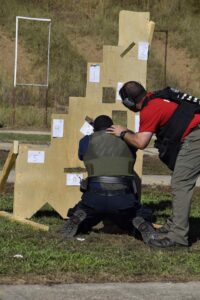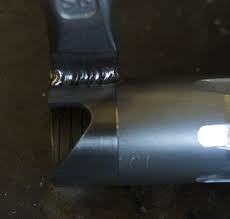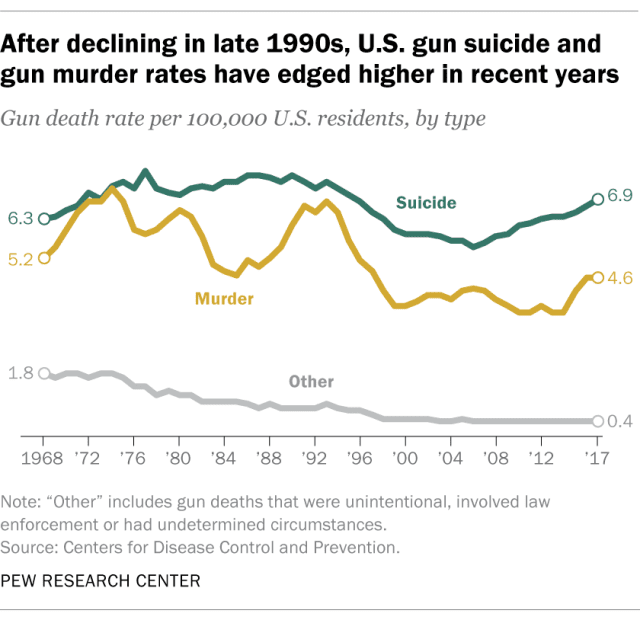BRTC's Gunsmithing Technology courses are safety-based and versatile depending on the needs and future aspirations of the student. Potential students will be advised into the program which best suits them. However, below are some general guidelines which will help students enroll in the best program.
1-Semester Program
- Best for students with a background and/or skills in machining
- Instructs students in gunsmithing skills utilizing their machining abilities
1-Year Program
- Best for students with no background and/or skills in machining
- Begins with basic machining skills
2-Year Program
- Composed of stackable credentials (CPs and/or TCs)
- Offers students gunsmithing proficiency
- Transferrable to certain 4-year colleges
Why BRTC's Program
Of the 11 accredited programs for gunsmithing in the United States,
- Only 4 are endorsed by the NRA and
- Only BRTC is the only institution connected to a law enforcement training academy.
With BRTC, only 12 colleges in the U.S. offer a gunsmithing program.
BRTC's program has many unique features.
Several LETA instructors already offer gun maintenance, care, safety, and instruction. In addition, BRTC has access to both a shooting range and a weapons vault.
Shooting Range
Gunsmithing students at BRTC have access to a police-quality shooting range whenever needed. This range allows for 20 shooters at one time, allows shooting up to 150 yards, and has concrete firing points every 25 yards.

BRTC LETA instructor teaching a LETA cadet to shoot from restricted areas
The site has 2 buildings from which smiths can shoot as well as picnic tables covered by an awning where adjustments to guns can easily be made on-site. LETA has a brass collector which speeds up the cleanup of spent bullet cases and maintenance is performed routinely by inmates housed at the Randolph County jail located next-door.
Weapons Vault
Safe storage of all weapons is also already integrated at LETA. College and community officials can be assured that no weapons will be accessible while unsupervised. The weapons vault at LETA is double-locked, has excessively limited access, and utilizes installed security cameras to maintain protection.
Law Enforcement Professionals On-Site
Because LETA utilizes a large number of outside adjuncts who work in the field, law enforcement professionals from all facets of security are frequently, even daily, on-site at Black River Technical College. Professionals assist LETA from a wide variety of law enforcement agencies include those from the following:
- Alcohol, Tobacco, Firearms, and Explosives (ATF) Bureau,
- Arkansas Highway Police,
- Arkansas State Police, and
- FBI.
Wildlife officers, constables, police chiefs and other ranks, SWAT and bomb team members, ex-military professionals, and other security officials are also utilized as adjuncts and guest lecturers. Each of these agencies and professionals have specialized knowledge of gunsmithing, handling, problems, and safety which would be invaluable to the gunsmithing student.
Machining skills are essential to gunsmithing. Machining ability and knowledge is central to gun part manufacture, gun building, scope drilling, barrel-making, modify existing gun barrels, installing slides, modifying pistol frames, and more.
Gunsmiths routinely use drills and lathes, both manual and CNC-controlled, in their every day work. These skills are precisely the skills taught in machine tool technology.

“One day after I retire I want to do gunsmithing. I’m here to gain the skills to achieve that goal.” James Lee, BRTC Machine Tool Technology student
Types of Machines at BRTC
BRTC machine tool technology already has the following machines essential to gunsmithing:
- manual lathes,
- manual end-mills,
- chevalier surface grinders,
- HAAS VF1 and VF2 CNC mills, and
- HAAS CCN lathe.

“The Computer Numerical Control (CNC) Mill can make any sort of odd shape we can come up with, from wheels for a motorcycle to parts for high-end guns.” Gary Meier, Machine Tool Technology instructor
Quality of BRTC’s Machines
BRTC utilizes state-of-the-art equipment which is standard in the business. The HAAS machines are the current industry standard used by many machining industries in and around Northeast Arkansas.
Welding skills are also essential to good gunsmiths. In particular, TIG welding is “especially helpful in making a difficult repair when the parts are very small and thin.” TIG is important for repairing, fabricating, and manufacturing gun parts. In addition, welding skills are useful in allowing gunsmiths to custom make their own gunsmithing tools which they will use later on.
BRTC’s machine tool instructor and welding instructor both teach TIG welding.
Other classes offered by BRTC are also very important to gunsmithing students. Such classes will help students be more successful in their career, especially if they decide to be a future business owner or work parttime for themselves.
- Business classes
- Accounting and spreadsheets classes
- Technical math
- Career Communications
- U.S. government
Before being accepted to the gunsmithing program, prospective students must apply to the college and adhere to the following:
- Complete the BRTC application for admission
- Follow and submit the required documents as identified in the admissions process
- Meet the minimum age requirements for gunsmithing technology as follows:
- Riflesmithing: Age 18
- Shotgunsmithing: Age 18
- Pistolsmithing: Age 21
- Work with BRTC to submit to a background check
Common Concerns
Guns are always a controversial topic and while every institution must fully consider the importance of implementing a new program, student, employee, and community safety is by far the most important concern.
This section is a reference to address potential concerns regarding the creation of a gunsmithing program at BRTC. While BRTC believes collaboration between a gunsmithing program and its existing Law Enforcement Training Academy is essential and will minimize potential problems, the college feels it is important to examine all potential concerns.
Actually, 1993 was the worst year for gun deaths. Over the past 20 years, gun deaths have declined although they have illustrated a spike in recent years.
Overall Gun Deaths
Guns deaths and suicides performed by guns are very concerning issues. Continually, Americans worry about the reported increase in gun deaths. However, the data show that gun deaths were actually higher in the 1970s and 1990s than they are now:
- 1993: 15.6 gun deaths per 100,000, the highest per capita on record
- 2017: 12.0 gun deaths per 100,000 the highest number on record
- 2000: 10.2 gun deaths per 100,000, the lowest number and per capita on record
While there were more gun-related deaths in 2017 than ever, 1993 was the highest year for gun violence on record once population changes are considered. In fact, the 1970s to 1990s had the highest number of gun deaths all of the recorded 40 years per capita
Gun Death by Suicide
In addition, while more than 50% of suicides are performed via a firearm in 2017, death by drug overdoes more than doubles the death by gun.
Bob Anderson, chief of the mortality statistics branch at the C.D.C.’s National Center for Health Statistics, believes the connection between suicides by gun and drugs are correlated:
there could be a correlation between drugs and gun deaths. While the gun death rate is higher than it has been in some time, he noted that it was even higher in the 1970s, 1980s and 1990s, which corresponded with heroin and crack cocaine epidemics.”
Arkansas is ranked 2nd highest in U.S. gun ownership with 57.9% of residents owning at least 1 gun. Further, a Pew Research Center reports in 2017 that 66% of gun owners own more than one gun. Arkansas is and is home to a wide variety of gun, ammo, and gun supply manufacturers.
While Arkansas ranks 2nd in the most guns owned nationwide, no program–accredited or unaccredited–exits in Arkansas to produce skilled, safety-conscious gunsmithing professionals who can work on guns. In fact, the nearest accredited program is in Oklahoma at the Texas border.
In addition, according to Guns & Ammo, Arkansas ranks 19th in gun-friendly laws. This ranking illustrates that Arkansas’ laws are not the most liberal in the country but also, by far, not the most restrictive.
BRTC takes the security of its community as well as the integrity of its program very seriously. Currently, BRTC administration is requiring FBI background checks for and holding in-person interviews with all potential students.
BRTC takes seriously every consideration of safety for students enrolling in the program as well as all college students, employees, and community members.
While having a gunsmithing program on campus will increase the number of guns and shooting by students in clearly designated areas, the college will continue following Arkansas state gun laws for college campuses as strictly as possible. For access to the BRTC Weapons on Campus policy, refer to the BRTC Campus Police page or the BRTC Course Catalog
In addition, firearms in the gunsmithing program will be continually under strict supervision and will be stored safely and securely when not in use.
Why Gunsmithing
Gunsmithing is the art of designing, building, and repairing firearms. Not only do gunsmiths replace parts on guns, they have the skills to make intensive repairs to guns, even making new parts for guns. Gunsmiths use machining skills to drill holes, thread barrels, and mount scopes. They use welding skills to join parts and make intensive repairs.
Reasons Gun Owners Own Guns
Armorers are usually employed by law enforcement agencies and repair parts and fix guns. Armorers, however, do not refinish, make, or do intensive repairs on guns like gunsmiths. However, armorers are often in demand in the law enforcement field where officers use guns frequently.
If repairing guns for hunters was the only task required of a gunsmith, gunsmithing may not be a priority of BRTC; however, many other industries desperately need local gunsmiths to not only repair weapons but to attach scopes, bore holes in barrels utilizing milling machines and lathes, and provide other detailed services.
In fact, Arkansas law enforcement agencies not located in the urban areas of the state desperately need gun repair technicians, called armorers. However, these departments do not have the funds to pay to send an officer to such classes when available.
At BRTC, because safety is our number one priority, our gunsmithing program will be infused with training from professionals at our Law Enforcement Training Academy.
Guns are very important to Arkansas’s economy:
-
60% of Arkansans own at least 1 gun.
-
Arkansas’ firearms and ammunition industry employed more than 6,000 local workers who collectively earned more than $281 million in 2017,
- Arkansas duck hunting brought in more than $100,000,000 in 60 days in 2009,
- More than 20,600 law enforcement officers were employed in Arkansas in 2016,
- In 2018, the City of Jonesboro invested $10 million in a shooting range and education center,
These industries and several others require gunsmiths to maintain, fix, and modify their guns.
Truly, gunsmithing is a specialized occupation. However, with only 11 academically accredited programs in the nation–and a handful of online, do-it-yourself, or correspondence schools available–the need for gunsmithing programs is real.
- Murry State University in Oklahoma has 10 times the number of applicants as spots in its program. Potential students come from all of the world to attend classes.
- Pittsburgh Gunsmith School in Pennsylvania has a two-year waiting list.
- Yavapai College reported in 2006 that it and all of the 4 other gunsmithing schools could not accommodate the demand for slots in the classroom.
Degree Plans
The Certificate of Proficiency in Gunsmithing Technology is most appropriate for those with a background in machining and is the foundation for the Technical Certificate in Gunsmithing Technology and the Associate of Applied Science in Gunsmithing Technology.
- 2025-2026 -- Certificate of Proficiency in Gunsmithing Technology, Riflesmithing
- 2024-2025 — Certificate of Proficiency in Gunsmithing Technology, Riflesmithing
- 2023-2024 — Certificate of Proficiency in Gunsmithing Technology, Riflesmithing
- 2022-2023 — Certificate of Proficiency in Gunsmithing Technology, Riflesmithing
- 2021-2022 — Certificate of Proficiency in Gunsmithing Technology, Riflesmithing
The Certificate of Proficiency in Gunsmithing Technology is most appropriate for those with a background in machining and is the foundation for the Technical Certificate in Gunsmithing Technology and the Associate of Applied Science in Gunsmithing Technology.
- 2025-2026 -- Certificate of Proficiency in Gunsmithing Technology, Shotgunsmithing
- 2024-2025 — Certificate of Proficiency in Gunsmithing Technology, Shotgunsmithing
- 2023-2024 — Certificate of Proficiency in Gunsmithing Technology, Shotgunsmithing
- 2022-2023 — Certificate of Proficiency in Gunsmithing Technology, Shotgunsmithing
- 2021-2022 — Certificate of Proficiency in Gunsmithing Technology, Shotgunsmithing
The Certificate of Proficiency in Gunsmithing Technology is most appropriate for those with a background in machining and is the foundation for the Technical Certificate in Gunsmithing Technology and the Associate of Applied Science in Gunsmithing Technology.
- 2025-2026 -- Certificate of Proficiency in Gunsmithing Technology, Pistolsmithing
- 2024-2025 — Certificate of Proficiency in Gunsmithing Technology, Pistolsmithing
- 2023-2024 — Certificate of Proficiency in Gunsmithing Technology, Pistolsmithing
- 2022-2023 — Certificate of Proficiency in Gunsmithing Technology, Pistolsmithing
- 2021-2022 — Certificate of Proficiency in Gunsmithing Technology, Pistolsmithing
The Technical Certificate in Gunsmithing Technology is most appropriate for the beginning student and is the first year of the Associate of Applied Science in Gunsmithing Technology. Students may begin directly in this program without first having completed a certificate of proficiency.
- 2025-2026 -- Technical Certificate in Gunsmithing Technology, Rifle Emphasis
- 2024-2025 — Technical Certificate in Gunsmithing Technology, Rifle Emphasis
- 2023-2024 — Technical Certificate in Gunsmithing Technology, Rifle Emphasis
- 2022-2023 — Technical Certificate in Gunsmithing Technology, Rifle Emphasis
- 2021-2022 — Technical Certificate in Gunsmithing Technology, Rifle Emphasis
The Associate of Applied Science in Gunsmithing Technology is a stackable credit which will incorporate the Technical Certificate and the Certificate of Proficiency if a student has them. Students may begin directly in the Associate of Applied Science in Gunsmithing Technology program without first having completed a technical certificate or a certificate of proficiency.
- 2025-2026 -- Associate of Applied Science in Gunsmithing Technology.
- 2024-2025 — Associate of Applied Science in Gunsmithing Technology
- 2023-2024 — Associate of Applied Science in Gunsmithing Technology
- 2022-2023 — Associate of Applied Science in Gunsmithing Technology
- 2021-2022 — Associate of Applied Science in Gunsmithing Technology
For More Information


Coe, Charles

B.S.E., Arkansas State University, M.S., University of Arkansas for Medical Science


A.A.S., A.A., Black River Technical College; B.S.E., M.S., Arkansas State University; MCSA; CompTIA: A+, Linux+, Cloud+ Certified; MOUS Certified




